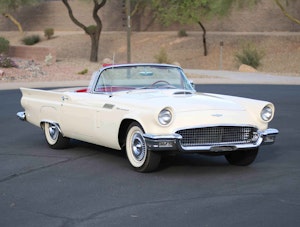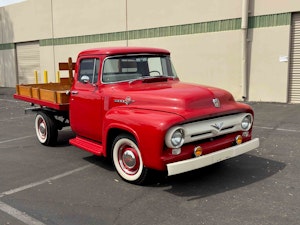Media | Articles
Driving the Bugatti Chiron is like being launched into luxurious orbit
Many a schoolyard daydream starts with the familiar query of what one might do with a million bucks. A house with a bowling alley? Lifetime supply of cookie dough ice cream, perhaps, or a team of nerds to do all your homework? No, the car-obsessed kid, of course, is headed straight for the perhaps most absurdly fast and luxurious street car money can buy—a Bugatti Chiron. But a million clams will only buy you a third of a Chiron, a car that is so synonymous with excess and hyperbole that it might as well use unicorn blood for oil instead of full synthetic.
OK, unicorns don’t exist. But is the reality of this monster much easier to swallow? The Chiron is an earthbound carbon-fiber ballistic missile that can go 261 mph courtesy of a 1500-hp, 8.0-liter W-16 engine with four turbochargers, all while carrying you, 14 cow hides worth of leather (yes, really), and a rapidly diminishing tank of premium unleaded. It is the absolute peak of what a hypercar can do without the aid of electric motors.
The Chiron manages these feats of extreme physics with equal parts ruthless German efficiency and aloof French nonchalance. On an empty California road, we stab the pale blue ENGINE button on the steering wheel to stir the quad-turbo behemoth behind our head, which rumbles to attention and settles into an even, clandestine idle. Switching the Chiron into Launch Control mode, we put our left foot on the brake, bring the engine up to 3000 rpm, and set off toward oblivion. By the time we can even think about how ungodly, stupidly quick this beast gets up to speed, it’s over. We’ve run out of straight road (and forgotten to breathe).
20180913175312)
20180913175256)
Marketplace
Buy and sell classics with confidence
20190319153141)
Ease on to the brakes, and our co-pilot, former Formula 1 driver Andy Wallace, lets on that the first run always suffers from a bit of heat soak, and that the second launch is where we’ll see the car’s full capability. Right. We’ll have to do this again, then. Once more—with a bellowing growl from its massive titanium exhaust—the Chiron is off like a private jet, turbocharger wastegates puffing with each instantaneous upshift like a quartet of NASA shuttle-sized Super Soakers simultaneously evacuating their water reserves. Zero to 60 happens in just 2.4 seconds in the Chiron, and it takes just 6.1 seconds to hit 124 mph. The dual-stage turbocharger system, in which only two of the turbos are running until the party becomes a foursome at 3800 rpm, provides a seamlessly and beautifully linear power delivery that well into the triple digits feels positively unending.
Somewhere between the blood departing our feet and the fear of swallowing our tongue, we once again run out of road and return to sane velocity. We barely went half as fast as the Chiron can muster when given enough room. Only through delimited sections of German autobahn or on a long, empty runway could you even make use of Bugatti’s special Top Speed ignition key, which allows drivers to pass the 236-mph base threshold and on to the full 261 mph limit.
Despite its herculean capabilities, anyone with a pulse and an appetite for adrenaline can easily drive the Chiron. It’s totally approachable, requiring no special skills or secret handshakes. And unlike many high-performance cars that are only satisfying to drive near their limits, the Chiron is a treat at any speed. The steering surprises us most, in that it feels generously weighted yet not overly heavy, lacks any discernible dead spot, and transmits just the right information back through the steering wheel. For a car that pushes the scales past 4400 pounds, the Chiron feels surprisingly lithe. Owing to its electronically controlled, adaptive shocks, the Chiron rides beautifully over varying conditions of pavement, never betraying the ultra-stiffness of its fully carbon-fiber monocoque. It corners flat and with confidence when pushed hard. Outside of some turbocharger hiss, the cabin is sensory-deprivation-chamber silent. Rear visibility is nonexistent and the footwell for the driver is a bit snug, but otherwise there’s really nothing bad to say. (And for $3M, anything less would be unforgivable.) Even after you’ve checked off the hard acceleration box, the Chiron continues to endear and satisfy.
20190319153133)
Then again, we can’t presume to understand the fabulous unreality that Chiron owners inhabit. None of these owners put aside extra money in a special jar on the fridge to one day finally afford a Bugatti; the average Chiron owner has a collection of 42 cars, 4.6 residences, 1.2 yachts, 2.7 private jets and—get this—3.6 helicopters. This car is a glorified designer handbag that can leave Hellcats in the dust. People in this world don’t bump into their neighbors at the grocery store.
And while no doubt the rich will continue to get richer, the number of Chirons planned for production is strictly limited to 500 units. While freshly-minted CEO and famously hardworking Stephan Winkelmann is pushing his new subjects in Molsheim to pursue ambitious projects like the track-focused Divo, he’s already admitted that this is the last go-round for the W-16, and that the Chiron’s replacement is all but destined for electric motors. That means the Chiron will truly be the last hypercar of its kind, something the market is already recognizing.
Two Chirons have thus far successfully sold at auction, for $3.7M and $4.1M apiece, while the older Veyron sells for $1.73M on average (depending on which variant). Modern Bugattis are so extreme, so expensive, so capable, and so rare that they’re essentially instant collectibles. But no matter what you think of its unspeakable price tag and wanton excess, the Chiron’s untouchable performance, impeccable materials, and complete ease of use delights at every turn. It deserves a poster on any kid’s bedroom wall.
20190319153148)








20180913174753)
20180913174856)
20180913175051)
20180913175203)
20180913175223)
20180913175016)
20180913175249)
20180913175304)
20180913174819)
20190319153200)

